A) have no questions but hundreds of answers.
B) have 100 questions and 3,000 answers.
C) have 1,000 questions but no answers.
D) never produce a winner.
Correct Answer

verified
Correct Answer
verified
Multiple Choice
Figure 2-18
Relationship between Price and Restaurant Meals 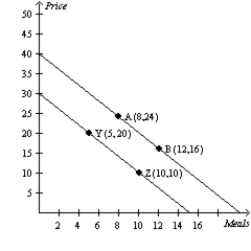 -Refer to Figure 2-18. Which of the following could result in a movement from point B to point Z?
-Refer to Figure 2-18. Which of the following could result in a movement from point B to point Z?
A) a change in the price of a restaurant meal
B) a change in the number of restaurant meals demanded
C) a change in income
D) Both a and b are correct.
Correct Answer

verified
Correct Answer
verified
Multiple Choice
The Federal Reserve
A) designs tax policy.
B) enforces the nation's antitrust laws.
C) sets the nation's monetary policy.
D) analyzes data on workers.
Correct Answer

verified
Correct Answer
verified
Multiple Choice
In the circular-flow diagram, which of the following items flows from households to firms through the markets for the factors of production?
A) goods and services
B) land, labor, and capital
C) dollars spent on goods and services
D) wages, rent, and profit
Correct Answer

verified
Correct Answer
verified
True/False
While the production possibilities frontier is a useful model, it cannot be used to illustrate economic growth.
Correct Answer

verified
Correct Answer
verified
Essay
In the markets for goods and services in the circular flow diagram, households act as
Correct Answer

verified
Correct Answer
verified
True/False
The President counts among his economic advisors the Congressional Budget Office.
Correct Answer

verified
Correct Answer
verified
Multiple Choice
Figure 2-14  Consider the production possibilities curve for a country that can produce sweaters, apples in bushels) , or a combination of the two.
-Refer to Figure 2-14. Which combination of points show production possibilities only achievable with improvements in technology or increases in resources?
Consider the production possibilities curve for a country that can produce sweaters, apples in bushels) , or a combination of the two.
-Refer to Figure 2-14. Which combination of points show production possibilities only achievable with improvements in technology or increases in resources?
A) Q, R, U, and V
B) S and X
C) T and W
D) None of the above is correct.
Correct Answer

verified
Correct Answer
verified
Multiple Choice
Figure 2-2 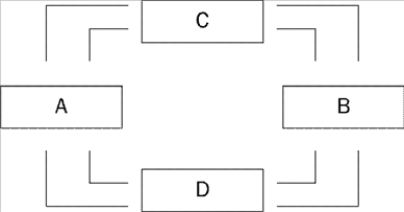 -Refer to Figure 2-2. Boxes A and B of this circular-flow diagram represent
-Refer to Figure 2-2. Boxes A and B of this circular-flow diagram represent
A) firms and households.
B) households and government.
C) the markets for goods and services and the markets for financial assets.
D) the markets for goods and the markets for services.
Correct Answer

verified
Correct Answer
verified
Essay
Suppose a war in the Middle East interrupts the flow of crude oil and oil prices skyrocket around the world. For economists, this historical episode serves as a
Correct Answer

verified
Correct Answer
verified
True/False
Assumptions can simplify the complex world and make it easier to understand.
Correct Answer

verified
Correct Answer
verified
Multiple Choice
Figure 2-9
Panel a) Panel b)
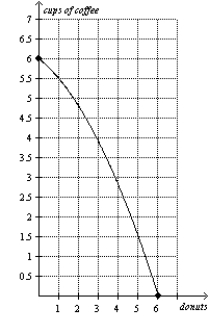
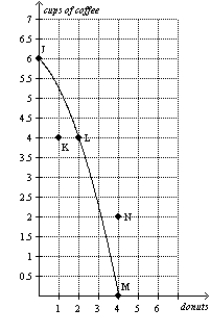 -Refer to Figure 2-9, Panel a) . The movement from point M to point K could be caused by
-Refer to Figure 2-9, Panel a) . The movement from point M to point K could be caused by
A) an advance in production technology.
B) an improvement in efficiency.
C) economic growth.
D) unemployment.
Correct Answer

verified
Correct Answer
verified
Multiple Choice
Which of the following is a positive, as opposed to a normative, statement?
A) The US Department of Justice should allow a merger between AT&T and T-Mobile because it would have little effect on consumers.
B) Antitrust laws should be used to prevent further concentration in the wireless telephone service market.
C) The US Department of Justice sued AT&T to block its merger with T-Mobile.
D) The wireless telephone service market is too highly concentrated.
Correct Answer

verified
Correct Answer
verified
Multiple Choice
Figure 2-8 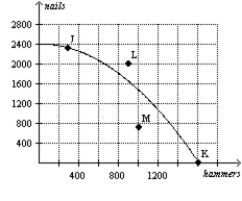 -Refer to Figure 2-8. Point K represents an outcome in which
-Refer to Figure 2-8. Point K represents an outcome in which
A) production is inefficient.
B) some of the economy's resources are unemployed.
C) the economy is using all of its resources to produce hammers.
D) the economy is using all of its nails to produce hammers.
Correct Answer

verified
Correct Answer
verified
Multiple Choice
If an economy is producing efficiently, then
A) there is no way to produce more of one good without producing less of another good.
B) it is possible to produce more of both goods without increasing the quantities of inputs that are being used.
C) it is possible to produce more of one good without producing less of another good.
D) it is not possible to produce more of any good at any cost.
Correct Answer

verified
Correct Answer
verified
Essay
Is the following a positive or normative statement? The federal minimum wage is lower than many state minimum wages.
Correct Answer

verified
Correct Answer
verified
Multiple Choice
The opportunity cost of obtaining more of one good is shown on the production possibilities frontier as the
A) amount of the other good that must be given up.
B) market price of the additional amount produced.
C) amount of resources that must be devoted to its production.
D) number of dollars that must be spent to produce it.
Correct Answer

verified
Correct Answer
verified
Essay
Just like other scientific models, economic models simplify reality using
Correct Answer

verified
Correct Answer
verified
Essay
When economists are trying to explain the world, they are scientists. When they are trying to improve it, they are
Correct Answer

verified
Correct Answer
verified
Multiple Choice
When an economist is asked a question like "why is unemployment higher for teenagers than for older workers?" the economist
A) is asked to explain the cause of an economic event.
B) is asked to recommend a policy to improve economic outcomes.
C) is asked as a policy adviser.
D) does not have enough information to respond.
Correct Answer

verified
Correct Answer
verified
Showing 421 - 440 of 620
Related Exams